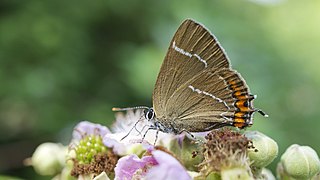
The white-letter hairstreak is a butterfly in the family Lycaenidae.

The black hairstreak is a butterfly in the family Lycaenidae.
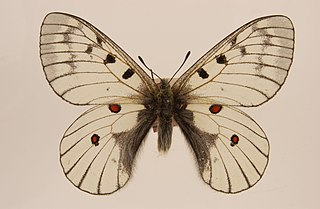
Parnassius bremeri is a high altitude butterfly which is found in Russia, Korea and China. It is a member of the snow Apollo genus (Parnassius) of the swallowtail family (Papilionidae). Over its vast range, the species varies widely in morphology and many subspecies have been described.

Satyrium acaciae, the sloe hairstreak, is a butterfly in the family Lycaenidae.
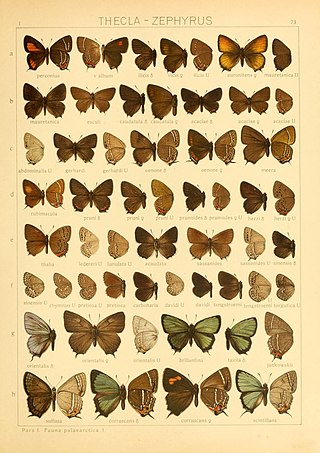
Satyrium ledereri, the orange banded hairstreak, is a butterfly in the family Lycaenidae.
Hipparchia azorina, the Azores grayling, is a species of butterfly in the family Nymphalidae. It is endemic to the Azores. Its natural habitats are temperate forests and temperate grassland. It is threatened by habitat loss.

Parnassius tenedius, the tenedius Apollo, is an east Palearctic member of the snow Apollo genus (Parnassius) of the swallowtail family (Papilionidae). Populations range from Siberia and the Far East of Russia to the western Chukchi Peninsula, Mongolia and north China. The larva feeds on Corydalis species. In the northern part of its range it is a low altitude butterfly; further south it is montane.
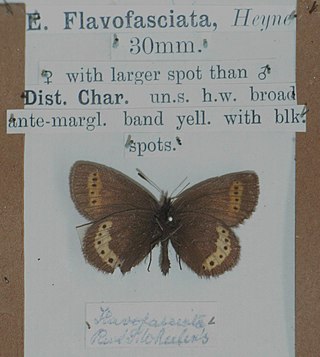
The yellow-banded ringlet is a member of the subfamily Satyrinae of the family Nymphalidae. It is a high mountain butterfly found in a small area of the Alps in Switzerland and Italy.

Parnassius staudingeri is a high-altitude butterfly which is found over a vast area - Pamirs, Altay Mountains, Hindu Kush, Karakorum and west Kuen-Lun.

Coenonympha arcania, the pearly heath, is a butterfly species belonging to the family Nymphalidae.

Coenonympha glycerion, the chestnut heath, is a butterfly species belonging to the family Nymphalidae. It can be found in Eastern Europe and east across the Palearctic to Siberia and the Caucasus to North Korea.
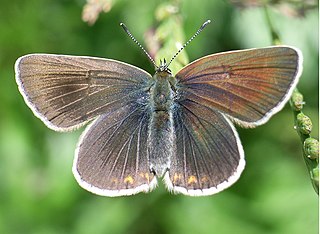
Eumedonia eumedon, the geranium argus, is a butterfly of the family Lycaenidae. It is found in the Palearctic realm. This butterfly has been included in the genera Plebejus, Plebeius, Polyommatus and Aricia, but recent molecular studies have demonstrated that Eumedonia is a valid genus, different from the previous genera mentioned.

Tomares ballus, the Provence hairstreak or cardenillo, is a butterfly of the family Lycaenidae. It is found on the Iberian Peninsula, northern Africa and along the Mediterranean coast of France.

Calliteara pudibunda, the pale tussock, is a moth of the family Erebidae. The Dutch common name for the moth (Meriansborstel) comes from the butterfly and insect painter Maria Sibylla Merian. The species was first described by Carl Linnaeus in his 1758 10th edition of Systema Naturae. It is found in Asia and Europe.

Satyrium mera is a butterfly of the family Lycaenidae. It is endemic to Japan. The larva on feeds on Rhamnus (Rhamnaceae). Satyrium mera is single brooded and overwinters as an egg.
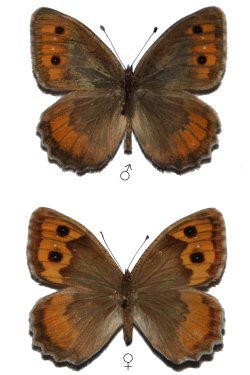
Pseudochazara mniszechii, the tawny rockbrown, is a species of butterfly in the family Nymphalidae. It is confined to Greece, Turkey, northern Iran, Balochistan, and the Caucasus.

Satyrium prunoides is a butterfly of the family Lycaenidae. It was described by Otto Staudinger in 1887. It is found in the Russian Far East, Mongolia, north-eastern China and Korea.

Satyrium herzi is a butterfly of the subfamily Lycaeninae. It was described by Johann Heinrich Fixsen in 1887. It is found in the Russian Far East, north-eastern China and Korea.

Araragi enthea is a small butterfly found in the East Palearctic that belongs to the lycaenids or blues family.

Mimathyma schrenckii is a butterfly found in the East Palearctic that belongs to the Nymphalidae family.

















